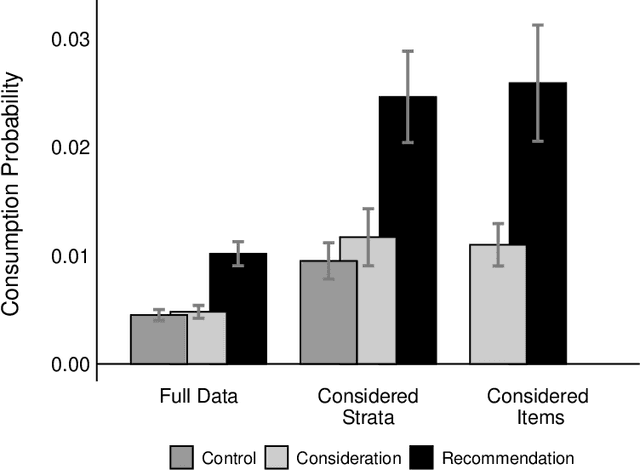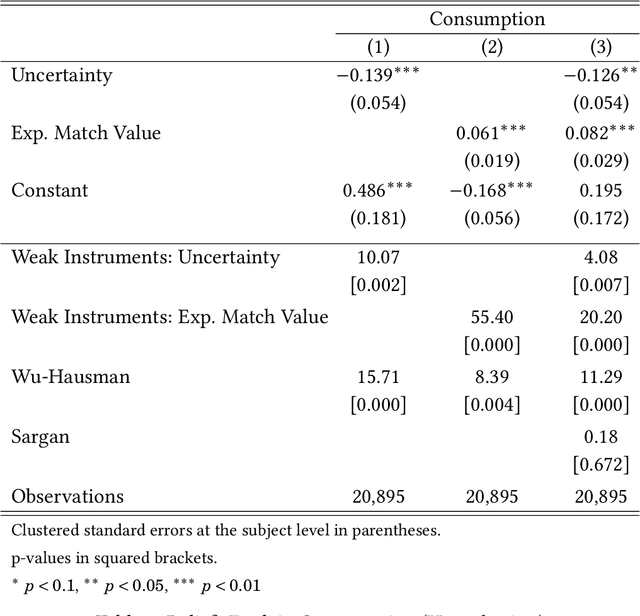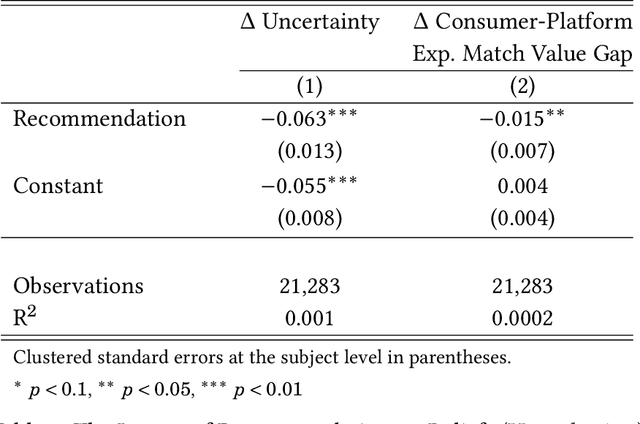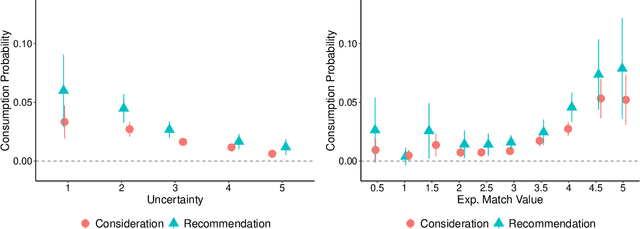Ruoyan Kong
The MovieLens Beliefs Dataset: Collecting Pre-Choice Data for Online Recommender Systems
May 21, 2024
Abstract:An increasingly important aspect of designing recommender systems involves considering how recommendations will influence consumer choices. This paper addresses this issue by introducing a method for collecting user beliefs about un-experienced items - a critical predictor of choice behavior. We implemented this method on the MovieLens platform, resulting in a rich dataset that combines user ratings, beliefs, and observed recommendations. We document challenges to such data collection, including selection bias in response and limited coverage of the product space. This unique resource empowers researchers to delve deeper into user behavior and analyze user choices absent recommendations, measure the effectiveness of recommendations, and prototype algorithms that leverage user belief data, ultimately leading to more impactful recommender systems. The dataset can be found at https://grouplens.org/datasets/movielens/ml_belief_2024/.
What Are We Optimizing For? A Human-centric Evaluation Of Deep Learning-based Recommender Systems
Jan 21, 2024Abstract:Deep learning-based (DL) models in recommender systems (RecSys) have gained significant recognition for their remarkable accuracy in predicting user preferences. However, their performance often lacks a comprehensive evaluation from a human-centric perspective, which encompasses various dimensions beyond simple interest matching. In this work, we have developed a robust human-centric evaluation framework that incorporates seven diverse metrics to assess the quality of recommendations generated by five recent open-sourced DL models. Our evaluation datasets consist of both offline benchmark data and personalized online recommendation feedback collected from 445 real users. We find that (1) different DL models have different pros and cons in the multi-dimensional metrics that we test with; (2) users generally want a combination of accuracy with at least one another human values in the recommendation; (3) the degree of combination of different values needs to be carefully experimented to user preferred level.
Organizational Bulk Email Systems: Their Role and Performance in Remote Work
Aug 09, 2023


Abstract:The COVID-19 pandemic has forced many employees to work from home. Organizational bulk emails now play a critical role to reach employees with central information in this work-from-home environment. However, we know from our own recent work that organizational bulk email has problems: recipients fail to retain the bulk messages they received from the organization; recipients and senders have different opinions on which bulk messages were important; and communicators lack technology support to better target and design messages. In this position paper, first we review the prior work on evaluating, designing, and prototyping organizational communication systems. Second we review our recent findings and some research techniques we found useful in studying organizational communication. Last we propose a research agenda to study organizational communications in remote work environment and suggest some key questions and potential study directions.
Less Can Be More: Exploring Population Rating Dispositions with Partitioned Models in Recommender Systems
Jun 20, 2023



Abstract:In this study, we partition users by rating disposition - looking first at their percentage of negative ratings, and then at the general use of the rating scale. We hypothesize that users with different rating dispositions may use the recommender system differently and therefore the agreement with their past ratings may be less predictive of the future agreement. We use data from a large movie rating website to explore whether users should be grouped by disposition, focusing on identifying their various rating distributions that may hurt recommender effectiveness. We find that such partitioning not only improves computational efficiency but also improves top-k performance and predictive accuracy. Though such effects are largest for the user-based KNN CF, smaller for item-based KNN CF, and smallest for latent factor algorithms such as SVD.
Getting the Most from Eye-Tracking: User-Interaction Based Reading Region Estimation Dataset and Models
Jun 12, 2023



Abstract:A single digital newsletter usually contains many messages (regions). Users' reading time spent on, and read level (skip/skim/read-in-detail) of each message is important for platforms to understand their users' interests, personalize their contents, and make recommendations. Based on accurate but expensive-to-collect eyetracker-recorded data, we built models that predict per-region reading time based on easy-to-collect Javascript browser tracking data. With eye-tracking, we collected 200k ground-truth datapoints on participants reading news on browsers. Then we trained machine learning and deep learning models to predict message-level reading time based on user interactions like mouse position, scrolling, and clicking. We reached 27\% percentage error in reading time estimation with a two-tower neural network based on user interactions only, against the eye-tracking ground truth data, while the heuristic baselines have around 46\% percentage error. We also discovered the benefits of replacing per-session models with per-timestamp models, and adding user pattern features. We concluded with suggestions on developing message-level reading estimation techniques based on available data.
* Ruoyan Kong, Ruixuan Sun, Charles Chuankai Zhang, Chen Chen, Sneha Patri, Gayathri Gajjela, and Joseph A. Konstan. Getting the most from eyetracking: User-interaction based reading region estimation dataset and models. In Proceedings of the 2023 Symposium on Eye Tracking Research and Applications, ETRA 23, New York, NY, USA, 2023. Association for Computing Machinery
HierCat: Hierarchical Query Categorization from Weakly Supervised Data at Facebook Marketplace
Feb 22, 2023Abstract:Query categorization at customer-to-customer e-commerce platforms like Facebook Marketplace is challenging due to the vagueness of search intent, noise in real-world data, and imbalanced training data across languages. Its deployment also needs to consider challenges in scalability and downstream integration in order to translate modeling advances into better search result relevance. In this paper we present HierCat, the query categorization system at Facebook Marketplace. HierCat addresses these challenges by leveraging multi-task pre-training of dual-encoder architectures with a hierarchical inference step to effectively learn from weakly supervised training data mined from searcher engagement. We show that HierCat not only outperforms popular methods in offline experiments, but also leads to 1.4% improvement in NDCG and 4.3% increase in searcher engagement at Facebook Marketplace Search in online A/B testing.
The Economics of Recommender Systems: Evidence from a Field Experiment on MovieLens
Nov 25, 2022



Abstract:We conduct a field experiment on a movie-recommendation platform to identify if and how recommendations affect consumption. We use within-consumer randomization at the good level and elicit beliefs about unconsumed goods to disentangle exposure from informational effects. We find recommendations increase consumption beyond its role in exposing goods to consumers. We provide support for an informational mechanism: recommendations affect consumers' beliefs, which in turn explain consumption. Recommendations reduce uncertainty about goods consumers are most uncertain about and induce information acquisition. Our results highlight the importance of recommender systems' informational role when considering policies targeting these systems in online marketplaces.
 Add to Chrome
Add to Chrome Add to Firefox
Add to Firefox Add to Edge
Add to Edge